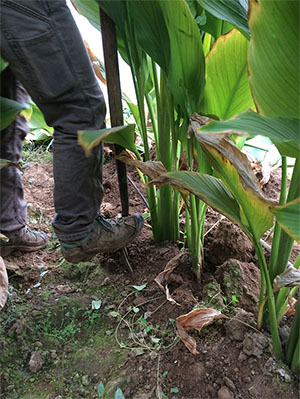Ginger and Turmeric
Ginger (Zingiber officinale Roscoe) and turmeric (Curcuma longa) both have a long history of use in Asian, African and Caribbean cuisines. Fresh ginger is available year-round in the U.S. and Canada from produce wholesalers sourcing from global suppliers, and both are widely available in their dried, ground form that is produced from their underground rhizomes. Producers in the northeast have successfully produced ginger in high tunnels, and experience with ginger and turmeric production (through the 2018 season) indicates both crops may be adaptable to high tunnel production in Kentucky.
Marketing
 Kentucky producers have focused on selling directly to consumers, using local market channels like farmers markets and community supported agriculture. A few producers also sell these specialty crops via wholesale marketing for restaurant chefs. Some food retailers focused on offering organic and local produce have reported sourcing ginger locally. Local farmers market customers and CSA members will benefit from recipes and preparation suggestions for fresh ginger. Shelf life and storage considerations should be conveyed to customers, as the fresh “baby” ginger in its immature stage produced in high tunnels will have different requirements than the mature ginger that is available at grocery stores. Turmeric producers should also provide use guidelines, as fresh turmeric is not commonly found in the marketplace. Common uses include using the vegetative tops of both plants to make teas, and both crops are used in juicing. Both rhizomes can also be dehydrated, pickled or candied.
Kentucky producers have focused on selling directly to consumers, using local market channels like farmers markets and community supported agriculture. A few producers also sell these specialty crops via wholesale marketing for restaurant chefs. Some food retailers focused on offering organic and local produce have reported sourcing ginger locally. Local farmers market customers and CSA members will benefit from recipes and preparation suggestions for fresh ginger. Shelf life and storage considerations should be conveyed to customers, as the fresh “baby” ginger in its immature stage produced in high tunnels will have different requirements than the mature ginger that is available at grocery stores. Turmeric producers should also provide use guidelines, as fresh turmeric is not commonly found in the marketplace. Common uses include using the vegetative tops of both plants to make teas, and both crops are used in juicing. Both rhizomes can also be dehydrated, pickled or candied.
Production
 Selecting high-quality, disease-free seedstock is important for growing ginger and turmeric. Growers in the continental U.S. usually purchase rhizomes from Hawaii. One popular ginger selection is ‘Bubba Blue.’ Quality seed pieces weigh 1 to 2 ounces and are shiny and clean with obvious rhizomes. Seed pieces can usually be purchased pre-cut for a nominal fee, or as whole “hands” (larger, intact rhizomes) that the producer will need to divide into smaller seed sections. Follow recommended seedstock handling and sanitation procedures. Turmeric cultivars, which take longer to mature than ginger, are less widely available; sourcing and seed handling procedures are similar to ginger.
Selecting high-quality, disease-free seedstock is important for growing ginger and turmeric. Growers in the continental U.S. usually purchase rhizomes from Hawaii. One popular ginger selection is ‘Bubba Blue.’ Quality seed pieces weigh 1 to 2 ounces and are shiny and clean with obvious rhizomes. Seed pieces can usually be purchased pre-cut for a nominal fee, or as whole “hands” (larger, intact rhizomes) that the producer will need to divide into smaller seed sections. Follow recommended seedstock handling and sanitation procedures. Turmeric cultivars, which take longer to mature than ginger, are less widely available; sourcing and seed handling procedures are similar to ginger.

